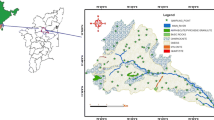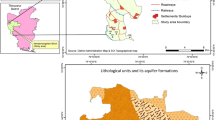Abstract
Hydrogeochemistry of groundwater is important for sustainable development and effective management of the groundwater resource. Fifty-six groundwater samples were collected from shallow tube wells of the intensively cultivated southern part of district Bathinda of Punjab, India, during pre- and post-monsoon seasons. Conventional graphical plots were used to define the geochemical evaluation of aquifer system based on the ionic constituents, water types, hydrochemical facies and factors controlling groundwater quality. Negative values of chloroalkaline indices suggest the prevalence of reverse ion exchange process irrespective of the seasons. A significant effect of monsoon is observed in terms chemical facies as a considerable amount of area with temporary hardness of Ca2+–Mg2+–HCO3 − type in the pre-monsoon switched to Ca2+–Mg2+–Cl− type (18%) followed by Na+–HCO3 − type (14%) in the post-monsoon. Evaporation is the major geochemical process controlling the chemistry of groundwater process in pre-monsoon; however, in post-monsoon ion exchange reaction dominates over evaporation. Carbonate weathering is the major hydrogeochemical process operating in this part of the district, irrespective of the season. The abundance of Ca2+ + Mg2+ in groundwater of Bathinda can be attributed mainly to gypsum and carbonate weathering. Silicate weathering also occurs in a few samples in the post-monsoon in addition to the carbonate dissolution. Water chemistry is deteriorated by land-use activities, especially irrigation return flow and synthetic fertilisers (urea, gypsum, etc.) as indicted by concentrations of nitrate, sulphate and chlorides. Overall, results indicate that different natural hydrogeochemical processes such as simple dissolution, mixing, weathering of carbonate minerals locally known as ‘‘kankar’’ and silicate weathering are the key factors in both seasons.








Similar content being viewed by others
References
APHA (1998) Standard methods for the examination of water and waste waters, 20th edn. APHA, Washington DC, USA
Aulakh MS, Bijay-Singh (1997) Nitrogen losses and fertilizer N use efficiency in irrigated porous soils. Nutr Cycl Agroecosys 47:197–212
Bertram J, Balance R (1998) Water quality monitoring: a practical guide to the design and implementation of freshwater quality studies and monitoring programmes, 1st edn. Taylor and Francis, USA., ISBN: 0419223207, pp 400
Cassman KG, Dobermann A, Walters D (2002) Agroecosystems, nitrogen-use efficiency, and nitrogen management. Ambio 31:132–140
Cederstorm DJ (1946) Genesis of groundwater in the coastal plain of Virginia. Environ Geol 41:218–245
Cerling TE, Pederson BL, Damm KLV (1989) Sodium-Calcium ion exchange in the weathering of shales: implications for global weathering budgets. Geology 17:552–554
CGWB Report (2007) Report on groundwater resources and development potentials of Bathinda district, Punjab
Chadha DK (1999) A proposed new diagram for geochemical classification of natural waters and interpretation of chemical data. Hydrogeol J 7:431–439
Comly HH (1987) Cyanosis in infants caused by nitrates in well water. J Am Med Assoc 257:2788–2792
Das BK, Kaur P (2001) Major ion chemistry of Renuka lake and weathering processes, Sirmaur district, Himachal Pradesh, India. J Environ Geol 40:908–917
Datta PS, Tyagi SK (1996) Major ion chemistry of groundwater in Delhi area: chemical weathering processes and groundwater regime. J Geol Soc India 47:179–188
Datta PS, Bhattacharya SK, Tyagi SK (1996) 18O studies on recharge of phreatic aquifers and groundwater flow-paths of mixing in the Delhi area. Hydrogeol J 176:25–36
Domenico PA (1972) Concepts and models in groundwater hydrology. McGraw-Hill, New York
Durov SA (1948) Natural waters and graphical representation of their composition. Dokl Akad Nauk SSSR 59:87–90
Fisher RS, Mulican WF III (1997) Hydrochemical evolution of sodium-sulfate and sodium-chloride groundwater beneath the Northern Chihuahuan desert, Trans-Pecos, Rexas, USA. Hydrogeol J 10:455–474
Garrels RM, Mackenzie FT (1971) Evolution of sedimentary rocks. WW Norton, New York
Gibbs RJ (1970) Mechanisms controlling world water chemistry. Sci J 170:795–840
Gilly G, Corrao G, Favilli S (1984) Concentrations of nitrates in drinking water and incidence of gastric carcinomas First descriptive study of the Piemonate Region, Italy. Sci Total Environ 34:35–37. doi:10.1016/0048-9697(84)90039-1
GSI (1976) Know your District Bathinda, Punjab—By Geological Survey of lndia, 1976
Gupta S, Thakur RS (1989) Report on hydrogeology of District Bathinda, Punjab State (F.S.P. 1989–93). Central Ground Water Board, North Western Region, Chandigarh
GWREC (1997) Report of groundwater resource estimation committee, Ministry of water resources, Government of India, New Delhi
Hem JD (1985) Study and interpretation of the chemical characteristics of natural water. USGS, Water Supply Paper, 2254:264
Holland HD (1978) The chemistry of the atmosphere and ocean. Wiley, New York
Hussein MT (2004) Hydrochemical evaluation of groundwater in the Blue Nile Basin, eastern Sudan, using conventional and multivariate techniques. Hydrogeol J 12:144–158. doi:10.1007/s10040-003-0265-5
Jankowski J, Acworth RI (1997) Impact of debris-flow deposits on hydrogeochemical process and the development of dry land salinity in the Yass River catchment, New South Wales, Australia. Hydrogeol J 5:71–88
Johnson CC (1979) Land application of waste—an accident waiting to happen. Groundwater 17(1):69–72
Johnson CJ, Bonrud PA, Dosch TL et al (1987) Fatal outcome of methemoglobinemia in an infant. J Am Med Assoc 257:2796–2797
Katz BG, Coplen TB, Bullen TD, Davis JH (1998) Use of chemical and isotopic tracers to characterize the interaction between groundwater and surface water in mantled Karst. Groundwater 35:1014–1028
Kross BC, Hallberg GR, Bruner R, Cherryholmes K, Johnson KJ (1993) The nitrate contamination of private well water in Iowa. Am J Public Health 83:270–272
Kumar M, Ramanathan AL, Rao MS, Kumar B (2006) Identification and evaluation of hydrogeochemical processes in the groundwater environment of Delhi. India J Environ Geol 50:1025–1039
Kumar M, Kumari K, Ramanathan AL, Saxena R (2007) A comparative evaluation of groundwater suitability for irrigation and drinking purposes in two agriculture dominated districts of Punjab, India. J Environ Geol 53:553–574
Mackenzie FJ, Garrells RH (1965) Silicates: reactivity with water. Sci J 1505:57–58
Matthess G (1982) The properties of groundwater. Wiley, New York, p 498
Maya AL, Loucks MD (1995) Solute and isotopic geochemistry and groundwater flow in the Central Wasatch Range, Utah. J Hydrol 172:31–59
Piper AM (1944) A graphic procedure in geochemical interpretation of water analyses. Trans Am Geophys Union 25:914–923
Pojasek RB (1977) Drinking water quality enhancement through protection. Ann Arbor Publishers Inc., Ann Arbor, p 614
Raj-Kumar, Balwinder-Singh, Hundal, HS, Kuldip-Singh, Yadwinder-Singh (2010) Geospatial quality of underground water of Punjab. Department of Soils, Punjab agricultural University, Ludhiana-141004, India, pp 72 + 26 figures
Rajmohan N, Elango L (2004) Identification and evolution of hydrogeochemical processes in the groundwater environment in an area of the Palar and Cheyyar River Basins, Southern India. Environ Geol 46:47–61
Sami K (1992) Recharge mechanisms and geochemical processes in a semi-arid sedimentary basin, Eastern Cape, South Africa. J Hydro 139:27–48
Sarin MM, Krishnaswamy S, Dilli K, Somayajulu BLK, Moore WS (1989) Major ion chemistry of the Ganga-Brahmaputra river system: weathering process and fluxes to the Bay of Bengal. Geochim Cosmochim Acta 53:997–1009. doi:10.1016/0016-7037(89)90205-6
Sastri JCV (1994) Groundwater chemical quality in river basins, hydrogeochemical facies and hydrogeochemical modeling. Lecture notes—refresher course conducted by school of Earth Sciences. Bharathidasan University, Thiruchirapalli
Schoeller H (1965) Qualitative evaluation of groundwater resources. In: Methods and techniques of groundwater investigations and development. UNESCO, pp 54–83
Schoeller H (1967) Geochemistry of groundwater—an international guide for research and practice, UNESCO
Schoeller H (1977) Geochemistry of groundwater. In: Brown RH et al (eds) Groundwater studies—an international guide for research and practice. UNESCO, Paris, pp 1–18
Schuh WM, Klinekebiel DL, Gardner JC, Meyar RF (1997) Tracer and nitrate movements to groundwater in the Norruem Great Plains. J Environ Qual 26:1335–1347
Sharma BD, Mukopadhyay SS, Sidhu PS (1998) Microtpographic controls on soil formation in the Punjab region, India. Geoderma 81:357–368
Sidhu PS, Gilkes RJ (1977) Mineralogy of soils developed on alluvium in the Indo-Gangetic plain (India). Soil Sci Soc Am J 41:1194–1201
Sidhu G, Walia C, Lal T, Rana K, Sehgal J (1995) Soils of Punjab for optimizing land use. Soils of India Series 4. National Bureau of Soils Survey and Land Use Planning, Nagpur, pp 1–75
Singh AK (2003) Water resources and their availability. In: Souvenir, national symposium on emerging trends in agricultural physics, Indian Society of Agrophysics, New Delhi, pp 18–29
Stallard RF, Edmond JM (1983) Geochemistry of Amazon, the influence of geology and weathering environment on the dissolved load. J Geophys Res 88:9671–9688
Statistical abstract of Punjab (2008) Government of Punjab, India
Subramanian V, Saxena K (1983) Hydrogeology of groundwater in Delhi region of India, Relation of water quality and quantity. In: Proceedings of the Hamberg symposium IAHS publication no. 146
Thomas A, Verma VK, Sood A, Litoria PK, Sharma PK, Ravindran KVl (1995) Hydrogeology of Talwandi Sabo Tehsil, Bathinda District (Punjab). J Indian Soc Remote Sen 23:47–56
Toth J (1984) The role of regional gravity flow in the chemical and thermal evolution of groundwater. In: Proceedings of the first Canadian/American conference on hydrogeology, Banff, Alta
Wadia DN (1981) Geology of India. Tata McGraw-Hill, New Delhi, p 508
WHO (1996) Water quality monitoring: a practical guide to the design and implementation of freshwater quality studies and monitoring programmes. E&FN Spon, London
WRD (1982) Hydrogeological studies in the area lying South of Satluz—By Hydrogeological Division, Water Resources Directorate (Govt. of Punjab). Chandigarh, June 1982
Acknowledgments
This research was supported by a grant given by the Government of Punjab, India, through NP-76 scheme. The authors would like to warmly thank Dr. James W. LaMoreaux (Editor-in-Chief) and anonymous reviewers for their valuable advice and suggestion to improve the quality of the paper.
Author information
Authors and Affiliations
Corresponding author
Rights and permissions
About this article
Cite this article
Kuldip-Singh, Hundal, H.S. & Dhanwinder-Singh Geochemistry and assessment of hydrogeochemical processes in groundwater in the southern part of Bathinda district of Punjab, northwest India. Environ Earth Sci 64, 1823–1833 (2011). https://doi.org/10.1007/s12665-011-0989-9
Received:
Accepted:
Published:
Issue Date:
DOI: https://doi.org/10.1007/s12665-011-0989-9




